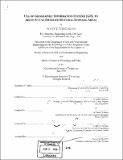Use of Geographic Information Systems (GIS) to aid in siting dredged material disposal areas
Author(s)
FitzGerald, Scott T., 1974-
DownloadFull printable version (47.34Mb)
Alternative title
GISite
Advisor
Judith Pederson and David H. Marks.
Terms of use
Metadata
Show full item recordAbstract
Dredging of the ports and waterways in the United States has implications for the economy and military preparedness and is hampered by a lack of disposal areas. Current dredged material disposal site selection methodologies have several limitations, such as a lack of early public involvement in the decision making process, inadequate documentation of the assumptions entering into decisions, lack of a holistic view, and inadequate consensus building among stakeholders. The use of an interactive Geographic Information System (GIS) approach to site dredged material disposal areas is seen as a way of updating and improving current site selection methodologies. There were three specific goals of this project: 1. To develop a management approach to improve the identification and selection of dredged material disposal sites; 2. To use GIS technology as a tool to facilitate the implementation and use of that approach; and 3. To evaluate the use of GIS technology and the new approach in siting dredged disposal areas. Any useful site selection methodology must acknowledge that site selection is an inherently political process based on interpretations and perceptions of the underlying science. A two part process for evaluating, ranking, and weighting data was adopted as an effective management methodology. This process allows for public involvement built upon good science and scientific interpretation of data. The development of an interactive GIS provides the tools needed to implement this methodology. The use of visual analysis, a holistic approach, and better documentation of the assumptions inherent in any decision contribute to adaptive management of disposal areas. In addition, the interactive capability of the GIS tool allows 'what if' scenarios to be examined and allows users to immediately understand the various factors affecting disposal site location and to examine the tradeoffs inherent in any siting decision. Feedback from public demonstrations of the proposed methodology confirms that this approach to siting disposal areas is an improvement over current methods. Because it aids consensus building and fosters an adaptive management approach, this methodology has the potential to site disposal areas with less time, cost, and opposition, resulting in a better selection.
Description
Thesis (S.M.)--Massachusetts Institute of Technology, Dept. of Civil and Environmental Engineering; and, (S.M.)--Massachusetts Institute of Technology, Technology and Policy Program, 1998. Includes bibliographical references (leaves 60-62).
Date issued
1998Department
Massachusetts Institute of Technology. Department of Civil and Environmental Engineering; Technology and Policy ProgramPublisher
Massachusetts Institute of Technology
Keywords
Civil and Environmental Engineering, Technology and Policy Program